By the early 1900’s the settlement of New Castle, Pennsylvania, centered at the confluence of the Neshannock Creek and Shenango River, was no stranger to flooding. Floodwaters had ravaged the downtown area on many occasions over the past century. One of the worst floods occurred on October 1-2, 1911, when heavy rains caused the Neshannock Creek to rapidly spill over its banks and swamp the surrounding business district. The front page headline of the New Castle News of Monday, October 2, 1911, proclaimed, “Worst Flood in City’s History Destroys $175,000 in Property.” Another raging flood on August 25-26, 1912, brought further damage to downtown New Castle. However, as bad as these events were, the worst was yet to come.
On Easter Sunday, March 23, 1913, devastating rain storms and tornados swept across the states of Nebraska, Iowa, Indiana, and Illinois. Omaha was the worst hit with severe damage to the city as 103 people lost their lives. At the same time heavy rains started to inundate the states of Indiana and Ohio and the western portion of Pennsylvania. Those rains, preceded by intense storms in the previous two weeks, continued for several days and before too long a disaster was looming.
In New Castle, where spring floods in the region were nothing new, there was some talk of being on guard for the possibility of major flooding. The first warning alarm was sounded in New Castle at 11:15pm on Monday, March 24, as scores of people swarmed the downtown area to see what was happening. Merchants also took measures to protect their businesses. At that time there were reports that the Neshannock Creek was flooding its banks in Volant and other locations to the north of the city.
By 2:00am on Tuesday morning the Neshannock Creek was overflowing its banks near the old South Mill Street Bridge and Euwers Furniture Store. For the next two and half hours the water rapidly spilled over into the streets and spread out through the neighboring areas. After a brief pause the water started rising again at 8:00am and soon started coming down East Washington Street for the first time. Before too long the area around the public square (or The Diamond as it is popularly known) was completely underwater and in some locations the water was three feet deep. Boats and rafts were used to help evacuate folks from homes and businesses in the downtown area. The water level of the Neshannock Creek soon stabilized but the worst was yet to come.
By late Tuesday morning, as rescue efforts along the Neshannock Creek were underway, reports started coming in about rapidly rising water along the Shenango River west of downtown. By noon a major disaster was apparent as the Shenango River angrily crested its banks. The lower reaches of Mahoningtown, known as Kilkenny and situated between the Shenango and Mahoning Rivers, was the site of the worst flooding and folks scrambled to reach higher ground. The water was six feet deep in some locations in Mahoningtown and on the West Side of New Castle. The tin and steel mills along the Shenango River had to stop production for a time as their boilers were threatened by rising waters. Meanwhile, communities downriver along the Beaver River, such as East Moravia and Wampum, suffered considerable damage as well.
The city was paralyzed by the worst natural disaster it had ever faced. Electric service and lights were out, most railroad service into the city was suspended, streetcar service was stopped, many homes and businesses suffered considerable damage to their basements and lower floors, and hundreds of people were left homeless in the chilly weather. The Rescue Mission and various churches served as temporary shelters for many displaced people. Two people lost their lives, including policeman Tom Thomas who drowned while attempting to rescue stranded people near the Shenango Tin Mill. The other death involved a five-year-old boy who accidently fell into the raging waters of the Neshannock Creek.
The bridges on the Shenango River struggled under the immense surge of water. In the early morning hours of Wednesday, March 26, the old wooden Black Bridge – the covered bridge at “the Narrows” – broke free and floated almost intact downriver to the amazement of onlookers. It smashed a water intake house of the Carnegie Steel Company, before continuing on and crashing against the Franklin Railroad Bridge. The Franklin Bridge, purposely weighted down with about eight railroad cars filled with coal, held for the time being but collapsed the following afternoon at 3:00pm. The broken up remnants of the Black Bridge floated free and soon hit the Gardner Avenue Viaduct, an antiquated structure previously slated for replacement. That bridge wilted and collapsed at 6:00pm. Further upriver, the Grant Street Bridge broke up and fell into the water in two main sections on Wednesday afternoon. Its remnants drifted downriver and came to rest against the West Washington Street Bridge, but that reinforced bridge was fortunate to survive intact.
It was another few days before most of the water had receded to allow for sufficient cleanup and repair operations to begin in New Castle. Mahoningtown was another story and remained underwater for another week or so. Additional policemen and National Guardsman of Troop F patrolled the streets, residents returned to their damaged homes, shop owners went about assessing their losses, schools reopened in the coming days, roadways and sidewalks were cleaned of debris, city workers attempted to restore power and water service, and the railroads struggled to resume operations. Several new bridges were eventually constructed to replace those lost on the Shenango River.
Total damage in New Castle was estimated to be about $2 million and it was months before things returned to a somewhat normal state. New Castle was hit hard, but the Great Flood of March 1913 is mostly remembered for the devastation it caused in Dayton, Ohio, where twenty feet of water immersed portions of the downtown area, killing 123 people and displacing another 70,000.
Flood prevention in western Pennsylvania (and elsewhere) obviously became a major source of debate, but it was until 1934 that the Pymatuning Dam was completed to finally control the water levels along the Shenango River. Major spring floods still occurred from time to time, including the memorable St. Patrick’s Day Flood of 1936, but nothing matched what New Castle experienced in March 1913.
To read about the Shenango River overflowing its banks in Pulaski and a warning being sent to New Castle click on: SHENANGO ON RAMPAGE ARTICLE. To read about how the railroads were hampered by the flooding click on: RAILROADS PARALYZED ARTICLE and RAILROAD NEARLY DESTROYED ARTICLE. To read an article about the loss of several bridges along the Shenango River click on: TWO MORE BRIDGES FALL ARTICLE. To read a good chronological account of the flood in New Castle click on: HISTORY OF BIG FLOOD ARTICLE. The railroads running through New Castle quickly recovered. To learn about how the Pennsylvania Railroad and Pittsburgh & Lake Erie Railroad were returning to operations on March 28 click on: PENNSYLVANIA MAY RUN TODAY ARTICLE and TRAINS START ON LAKE ERIE ARTICLE. To read more about the serious situation regarding the loss of bridges click: COUNTY BRIDGE SITUATION ARTICLE. To learn about a man who thought (incorrectly) that he had lost his wife and child click on: THOUGHT WIFE AND BABY DEAD ARTICLE. To see post-flood ads that appeared in the New Castle News from Brown & Hamilton Co. and Mellin’s Store click on: POST-FLOOD STORE ADS. To learn about flooding throughout Lawrence County click on FLOODS ALL OVER COUNTY ARTICLE. To read an article about two of the many heroes of the flood click on: TWO FLOOD HEROES ARTICLE. To read an article detailing sister city Erie sending aid, the police force swearing in reinforcements, and the prevention of looting click on: ERIE TO SEND 1,000 LOAVES ARTICLE. To learn about how teams of wagons were finally able to get through on West Washington Street on March 28 click on: TEAMS GET THROUGH ARTICLE. To read about the damage done to the YMCA click on: HEAVY LOSS AT THE NEW YMCA ARTICLE. To read more about the conditions south of New Castle along the Beaver River click on: EAST MORAVIA BADLY FLOODED ARTICLE and WAMPUM BRIDGE STILL INTACT ARTICLE. To read a short mention of telephone service interruption to Mahoningtown click on: NO PHONE SERVICE ARTICLE. To learn more about the death of policeman Tom Thomas click on: OFFICER DROWNED ARTICLE. To read about the recovered body of Thomas being removed to his home click on: BODY REMOVED ARTICLE. To read a short mention of the loss suffered by Euwer’s Furniture Store click on: EUWER’S LOSS ARTICLE and EUWER’S AD. To read an early assessment of the damage click on: LOSS WILL MOUNT INTO MILLIONS ARTICLE. To learn more about the recovery effort click on: RESUMING FORMER LIFE ARTICLE. Some folks decided against returning to the flooded areas. To read more about that click on: PEOPLE DESERT FLOOD SECTIONS ARTICLE. To read about the miserable conditions still rampant in the Kilkenny district a month after the flood click on: NO AID FOR KILKENNY ARTICLE. To read about the abundance of frog ponds created by the flooding in Kilkenny click on: FROG PONDS ARTICLE.
 The downtown area of New Castle was under a constant danger of flooding. This photo depicts the aftermath of a flood on August 25-26, 1912. Spectators line up along Croton Avenue to get a look at the swollen waters of the Neshannock Creek. The work of erecting the New Castle Dry Goods Building (beside bridge) has already began – and its waterproof basement is completely flooded. The following spring would bring the worst flooding the city has ever seen. (Aug 1912) Full Size |
 |
 This photo shows the Shenango River as it inundated the area around the Grant Street Bridge, which is underwater and about to collapse on the afternoon of March 26. (Mar 1913) |
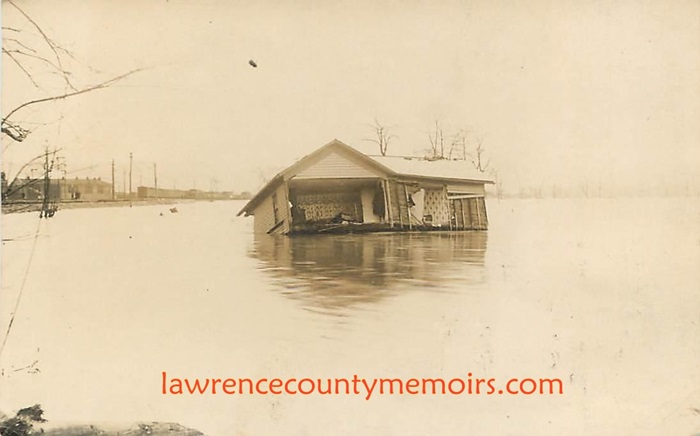 A house drifts afloat in New Castle during the Great Flood. (Mar 1913) Full Size |
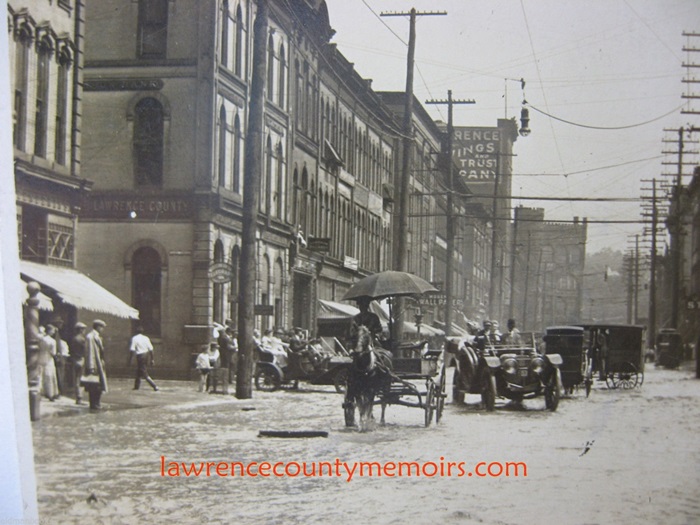 The downtown streets of New Castle were quite a sight during the flooding. (Mar 1913) Full Size |
 A great photo showing the remains of the Franklin Railroad Bridge, which collapsed in the afternoon of March 27 after being struck by the runaway Black Bridge. Several railroad cars, previously filled with coal to weigh down the bridge, can also be seen in the water. The Madonna Catholic Church can be seen up the hillside in the neighboring district of Oakland. (Mar 1913) Full Size |
 |
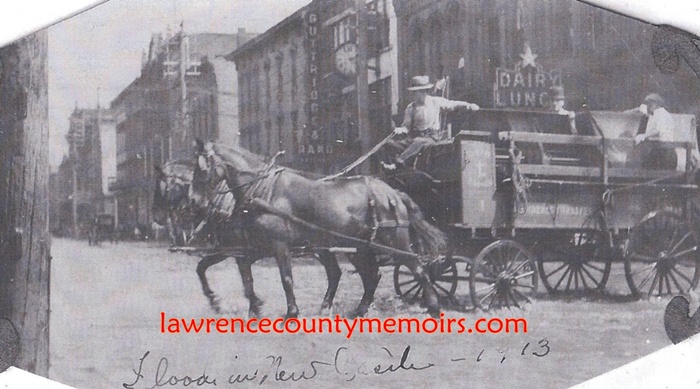 It appears these men might be moving pianos or organs in the aftermath of the flooding. In the background can be seen the signs for the Dairy Lunch and also Guttridge & Rand, a men’s fine tailoring business located at #112 East Washington Street. (Photo courtesy of Sherry Slater) (Mar 1913) Full Size |
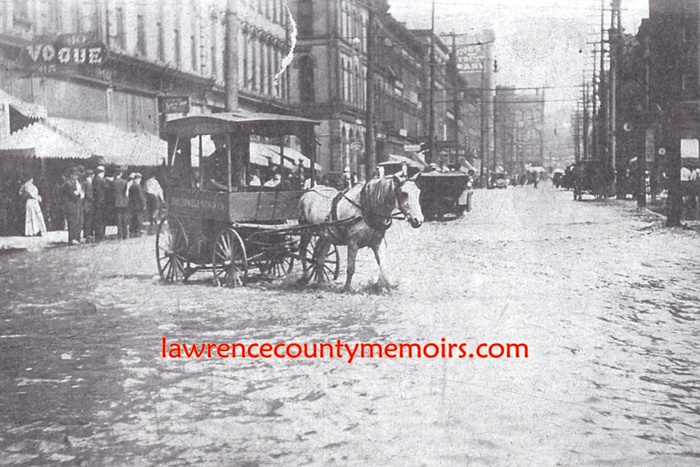 A horse and wagon move along East Washington Street during the flooding. (Mar 1913) |  A number of homes and small buildings were dislodged from their foundations by the raging waters. (Mar 1913) |
 Small boats were a common sight in the flooded areas of downtown New Castle. (Mar 1913) Full Size |
 Children play in the water along South Mill St. in downtown New Castle. (Mar 1913) |  A horse-drawn wagon passes a modern vehicle near the Soldier’s Monument at the Diamond. (Mar 1913) |
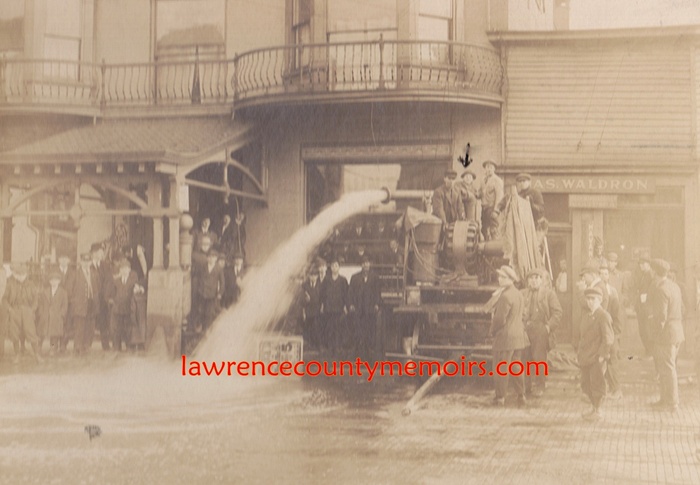 Workmen pump water out of the flooded basements in downtown New Castle. (Mar 1913) Full Size |
 Pumping out the basement of a downtown business. The sign near the window reads, “This Motor And Power Furnished By The New Castle Electric Co. The Cheapest And Best Power Is Electricity.” (Mar 1913) Full Size |
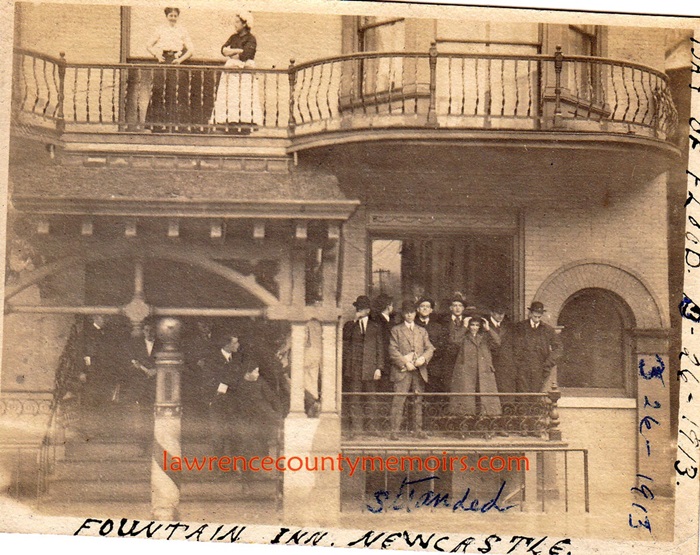 Patrons stranded on the steps and balcony at the Fountain Hotel in New Castle during the flood on March 23, 1913. (Mar 1913) Full Size |
 Men prepare to evacuate people from the front of the Leslie Hotel. (Mar 1913) |  A woman is being evacuated from the downtown area. (Mar 1913) |
 The Beaver River raged all the way down to Pittsburgh. This photo shows the water pouring over the dam near the Tenth Street Bridge in Beaver Falls. (Mar 1913) Full Size |
 New Castle was lucky compared to what the citizens of Dayton OH experienced when the Great Miami River overflowing its banks at the same time. Twenty feet of water inundated many portions of the downtown area. Total casualties in that city amounted to 123 people killed, with another like number killed in the surrounding areas. Almost 70,000 people were displaced from their homes in the city. In the photo above rescue workers arrived to evacuate stranded citizens. (Mar 1913) Full Size |













Comments
Pat Mahon #
How do I click on the articles?
Karleen Chirozzi #
That 5 year old boy who lost his life in the 1913 flood was my great uncle Peter Chirozzi.
Pat Ferver Russell #
10th Street Bridge & dam. Note the dam is broken on the far side of the pic.
Is this “the breaking away of the mill dam” as noted in the papers? (New Castle Herald, April 2, 1913 pp. 5)
According to the paper, the dam broke about the center, and was already damaged from last year’s storm. Anybody know if these are two different dams?
Thanks!
Comment